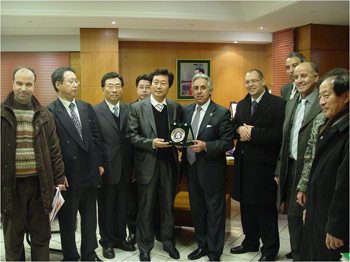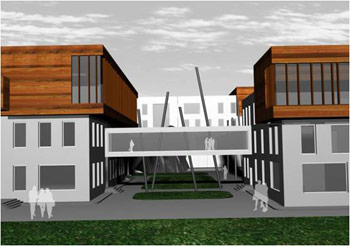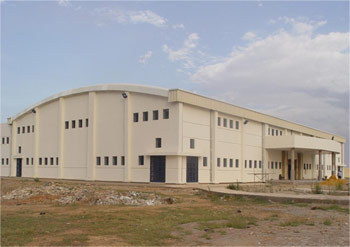Sidi Mohammed Ben Abdellah University: World Scientific Research & Student Development
Morocco Top Stories
Sidi Mohammed Ben Abdellah University (SMBAU)
It has 81 research laboratories, more than 240 research groups, and in 2010 had 521 Doctoral students enrolled.

Sidi Mohammed Ben Abdellah University (SMBAU)
Ambitious Plans
University City
SMBAU—Challenging itself
The Liberal Arts
Economic Development and Tourism
Outreach
Since its creation in 1975, SMBAU has witnessed a remarkable development in terms of its effectives, institutions and researchers. Today, SMBAU is Morocco’s largest and most important research and teaching university, with four principal campuses; 61,000 students; 1,200 faculty and over 700 staff. SMBAU is the major center for the nationally significant research in all fields of applied science and technology, clean energy, water management, medicine and pharmacy, public health, law, economics, business, management, and the Humanities.
It has 81 research laboratories, more than 240 research groups, and in 2010 had 521 Doctoral students enrolled. SMBAU sees itself as the scientific and technical side of the renaissance of education in Morocco’s cultural capital, Fes. Its aim is to become a great world university. SMBAU’s location in Fes is not by accident, as its president, Esserrhini Farissi explains:
Fez is a university city par excellence since its foundation in 789 by Idriss I. this truth becomes more valid by the presence of Al Karaouine University (859) as the first in the world to grant university degrees. The presence of Sidi Mohamed Ben Abdellah University, then, is not by chance for it is a logical result of a precious intellectual legacy passed by Al Karaouine University. Whereas Al Karaouine University stands for traditional education concerned with graduating judges and jurists, SMBAU represents, in a general sense, the modern side of Fez Academia in an attempt to go hand in hand with the rapid technological and economic advance.
According to Farissi, “Morocco is in a strategic situation very different from that of Dubai or Lebanon. It is Europe’s neighbor; only 14 km from Spain. Morocco’s situation is unique in that it is internationally oriented.” Farissi says SMBAU has unique advantages for it to become a world-class university:
– a strong presence of international students: mostly African students, but also students from much further countries such as Indonesia, Malaysia, Bangladesh…
– a strong presence of instructors and researchers abroad, especially in Europe, but also in the United Arab Emirates, for example.
– a dramatic increase in the number of students (20% since last year), unlike France and other European countries.
– a strong presence of Moroccan students abroad.
– tight ties with the EU: Morocco has a choice position in the European educational system
– In 2003, SMBAU adopted the European LMD system in regard to academic standards and today SMBAU’s degrees are recognized by the EU. Farissi also believes in SMBAU’s goal of becoming a major international university because of the attitudes in Morocco:
Since forever, Morocco has been open and tolerant. Students feel at home. African students that come here don’t feel any distinction is being made between them and Moroccan students. We want international students, who are away from their families and customs, to find comfort when they come. I think students find that warmth here in Morocco. Hospitality is essential in our culture: when someone knocks on your door, you have to smile at them and say “Marhaba” [Welcome].
We have an ambitious project to develop sport qualities of our students. This project embraces a modern sports hall at a cost of 16 million dirhams; a soccer field equipped with synthetic grass and night lighting, thanks to the 8 million dirhams budget allocated by the Ministry of Sports
But Farissi is not relying only on an open attitude. SMBAU has developed an outstanding cluster of scientific and technical laboratories and curricula. Its projects involve advanced scientific techniques (the case of National Institute for Medicinal and Aromatic Plants), environmental engineering, water management, and sustainable development, and in its 81 laboratories it works on a multitude of collaborations with private industry and governmental agencies.
Ambitious Plans
But Farissi is not relying on welcoming attitudes alone to build up SMBAU, instead he has an ambitious series of plans and projects to develop the university to world-class standards, including:
– improve student management with better individual support and the creation of new institutions;
– improve students’ life. We have an ambitious project to develop sport qualities of our students. This project embraces a modern sports hall at a cost of 16 million dirhams; a soccer field equipped with synthetic grass and night lighting, thanks to the 8 million dirhams budget allocated by the Ministry of Sports…[and] a number of other sport facilities to be introduced very soon including a semi-Olympic swimming pool, 8 tennis courts, 2 handball courts, 2 basketball courts, 2 volley ball courts along with a clubhouse…. For these last mentioned sport facilities, we hope that the Ministry of Sports would provide additional support together with other sponsors. 
– turn to the Mediterranean: we want to be part of a new Arab theaters network, and organize international tournaments.
– diversify our international relations, with Indonesia, Japan, the United Arab Emirates, china, USA…
– promote our researchers. We have about 1200 instructors, some of them are pioneers in their field; but so far we didn’t promote and advertise them as they deserve.
– promote our most talented students, including in the sports department. (“I believe a good student should take care of their mind and body, while being interested in music and culture,” says Farissi, adding, “this is my Greek side.”)
– to adjust available courses of studies to the country’s specific needs for development. This process has already started with the graduation this year of 112 state engineers.
– have an entrepreneurial approach to our university’s 13 institutions, based on performance and productivity.
– restructure financial and administrative management. Do you know that all 61’000 students don’t pay any fees? Our financial support comes from the government and our collaboration with the EU. We benefit from a large budget, and we must manage it well.
University City
But perhaps the greatest project being undertaken by SMBAU as it outgrows its present facilities is to build an entirely new “University City.” SMBAU has grown rapidly to reach its present enrollment of 61,000 students. But the vision for the future is to grow to 100,000 students in the next five years.
Morocco’s largest and most important research and teaching university, with four principal campuses; 61,000 students; 1,200 faculty and over 700 staff.
Expansion is planned for a 100 hectare area near Ain Chegag, a strategic spot close to the Fes airport. Plans are being finalized to “fully satisfy the academic needs of students, professors, and administrative staff,” and in cooperation with the Ain Chegag municipal government and the governor of Sefrou city, with the expectation of completion by 2015. This new campus, a city in itself, is being financed by the Moroccan national government and other national and international sponsors.
SMBAU—Challenging itself
President Esserrhini Farissi sees his greatest challenge, however, in raising SMBAU’s international reputation to meet the reality on the ground. So far, unfortunately, SMBAU’s reputation has not spread far beyond Morocco. Farissi sees this as a challenge of self-overcoming:
To tell you the truth, we’re most challenged by ourselves. We have a lot of assets…state-of-the-art technology laboratories, very good researchers… all that potential needs to be used to our advantage. We have to be very demanding of ourselves in order to exploit our wealth and make it known to the rest of the world. Globalization and competitivity are our biggest challenges. The world ranking does not reflect the quality of our university. We must therefore promote it, “commercialize” it, have a marketing approach of our advantages in terms of scientific research. We have highly qualified researchers and I don’t want their work to be locked in laboratories….
The Liberal Arts
SMBAU is not only intended as a scientific and technological institution, but is also dedicated to the full panoply of university studies in the liberal arts, and many “clusters” or inter- or multi-disciplinary programs, which it organizes as “Themes” of study, such as,
– Theme 1: Heritage, History and Archaeology
– Theme 2: Scientific Investigation of Heritage
– Theme 3: Scientific Documentaion on Heritage
– Theme 4: Heritage, Local Development and Planning
– Theme 5: Heritage and socio-economic, legal and institutional issues.
Economic Development and Tourism
SMBAU is viewed as a major player in all of Morocco’s goals for economic development. Foremost among these, according to Farissi, is the education of 10,000 engineers and 3,300 doctors and social workers for the economy. It is also playing a leading role in the development of tourism. “In the past, when we used to talk about tourism in general,” explains Farissi, “we usually had the tendency to highlight imperial cities and their characteristics. Yet, today, we become more conscious of very rich natural resources which are in constant call for their being investigated and discovered. A large virgin natural world, within the framework of ecotourism, needs to be valorised
and well-publicised.” New areas of research are being carved out into interdisciplinary blocks, such as the study of dinosaur cemeteries, fossils and caves of 160 to 170 million years old, and to preserve the richness of these natural resources, we are in the process of creating a scientific museum within the SMBAU’s presidency. “In this respect,” says Farissi, “we are working to promote scientific research of our professors in areas of:
– Operational Ecology, Fossiliser and mineral rocks
– Geology of Natural Resources
– Geomatics applied to natural resources (remote sensing and Geographic Information System “GIS”)
A core objective of these areas of research is to produce, for example, booklets, tourist guidebooks of scientific nature and provide new geological and geophysical modeling maps to best represent the natural richness and tourist qualifications of the whole region. Beyond its contribution to tourism, SMBAU is committed to working with private enterprises of every nature to develop the resources of Morocco. According to Farissi,
“SMBAU is becoming a big corporation aiming to establish relations with private companies. A case in point is our institute for Aromatic and Medicinal Plants that works with enterprises from France.”
In this regard, SMBAU has signed on March 1st, 2011 a very important convention with Ministry of Industry, Trade and New Technologies, aiming at transforming Regional University Centre for Interface (RUCI) into sites of innovation, opening the door, hence, for fruitful collaboration between the university and the enterprise.
Outreach
SMBAU is committed to increasing its ties to institutions of higher education around the world. It already has significant relations with numerous universities in the EU, especially in France. It is now directing its attention to Asia and the Arab world. Concrete agreements have already been started with countries like Indonesia, Malaysia, Japan, and China. In the Arab world, relations are being established with universities in the Kingdom of Bahrain, Saudi Arabia, Algeria, Lebanon, Sudan, and Egypt.